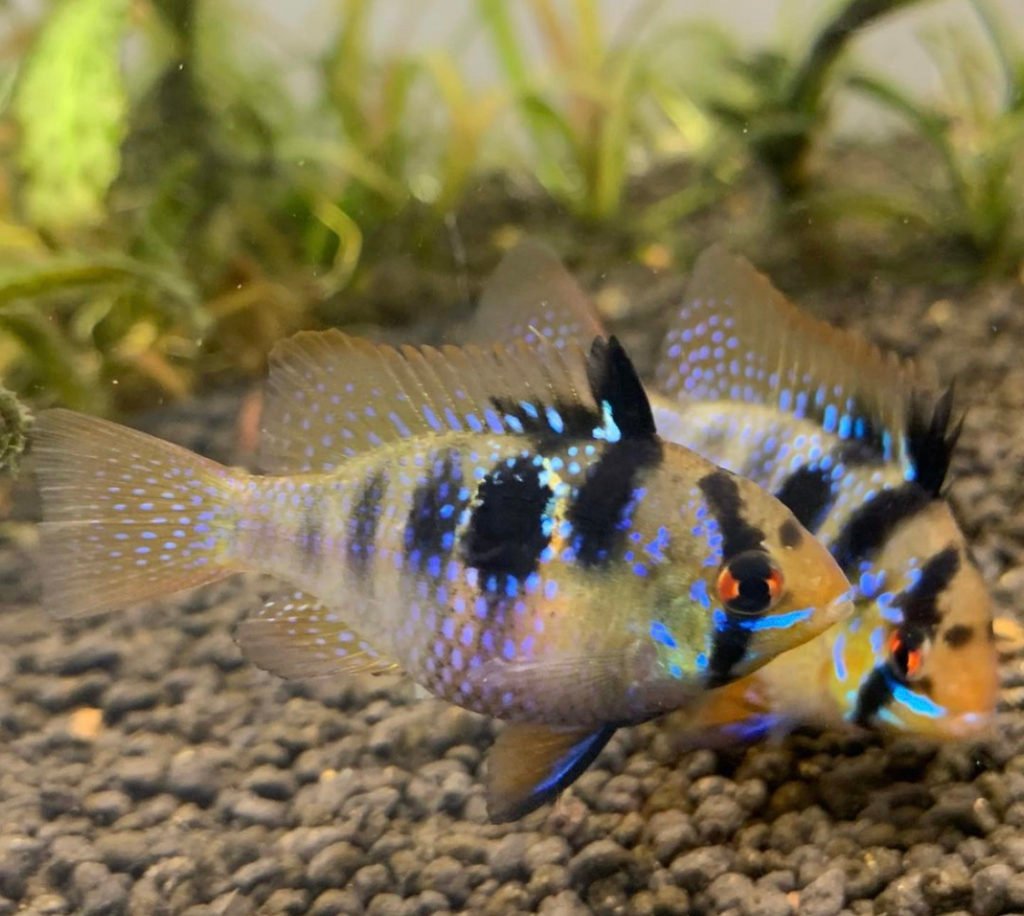German Blue Rams are beautiful fish, but they need proper care. Learn how to care for German Blue Rams and create a stunning aquatic world.
Are you considering adding German Blue Rams to your aquarium but need help to care for them?
Fear not! This comprehensive guide will explore everything you need about caring for these beautiful and fascinating fish. From understanding their unique needs and preferences to maintaining a thriving environment, we’ve got you covered. So, let’s dive in and discover the essential tips and tricks for keeping your German Blue Rams happy and healthy.
German Blue Rams: A Brief Overview
German Blue Rams (Mikrogeophagus ramirezi) is a widespread freshwater fish species known for its vibrant colors and peaceful nature. They originate from the Orinoco River basin in South America, where they inhabit slow-moving, warm waters. If properly cared for, these little cichlids make beautiful community aquarium additions.

German Blue Rams Fish Types
It’s fantastic to see how many variations of the German Blue Ram are being selectively bred for specific color patterns and fin shapes!
Some of the more popular types include:
- Gold Rams: These fish have a gold-toned body with a hint of blue iridescence.
- Electric Blue Rams: Known for their striking blue coloration, these fish are highly sought after by aquarists.
- Balloon Rams: They have a unique, rounded body shape, which gives them their “balloon” appearance.
Setting Up the Perfect German Blue Rams Tank
One of the critical factors in keeping your German Blue Rams healthy is providing them with the right environment. Here are some essential elements to consider when setting up their tank:
- Tank size: A minimum of 20 gallons is recommended for a pair of German Blue Rams. A larger tank is necessary to keep more or add other fish species.
- Water parameters: German Blue Rams prefer soft, slightly acidic water with a pH of 6.0-7.0 and a temperature between 78-86°F (25-30°C). Regularly test your water parameters and make adjustments as needed.
- Substrate: A soft, sandy substrate is ideal, as these fish like to sift through the substrate in search of food.
- Hiding spots: Provide plenty of hiding spots using rocks, caves, and driftwood to help your German Blue Rams feel secure and reduce stress.
- Plants: Live plants like Amazon swords, java ferns, and Anubias not only enhance the aesthetic appeal of your aquarium but also provide additional hiding spots and improve water quality.

What Do German Blue Rams Eat?
Feeding your German Blue Rams a balanced and varied diet is crucial for their health and well-being. They are omnivorous and thrive on high-quality flake or pellet food and live or frozen foods such as brine shrimp, bloodworms, and daphnia. Offering vegetables like blanched spinach or cucumber can also provide essential nutrients and variety in their diet.
How Often to Feed German Blue Rams
Feed your German Blue Rams small portions 1-2 times daily, ensuring they consume all the food within a few minutes. Overfeeding can lead to poor water quality and health problems, so avoiding giving them more than they can eat quickly is essential.
Social Behavior and Tank Mates
German Blue Rams are generally peaceful and do well in community aquariums with other non-aggressive species. However, they can be territorial, especially during breeding times. To avoid conflicts, provide ample hiding spots and enough space for each fish.
Can German Blue Rams Live Alone?
While German Blue Rams can technically live alone, they tend to thrive in pairs or small groups, as they are social fish that enjoy interacting with their kind. When keeping them in a group, ensure a proper male-to-female ratio, ideally with one male for every two or three females.
How Many German Blue Rams Should Be Kept Together?
A pair or a small group of German Blue Rams is recommended for a harmonious environment. If you keep a group, aim for at least five individuals to minimize aggression and territorial disputes. Provide ample space, hiding spots, and suitable tank mates for a stress-free environment.

What Temperature Do German Blue Rams Like?
German Blue Rams are sensitive to water temperature and prefer a warmer environment. They thrive in water temperatures between 78-86°F (25-30°C). Maintaining a stable temperature within this range is crucial for their health and well-being.
Using a Heater and Thermometer
To ensure the temperature remains consistent, use a reliable aquarium heater and thermometer to monitor and maintain the desired water temperature. Sudden fluctuations can cause stress and weaken your fish’s immune system, leading to potential health issues.
Common Health Issues and Preventative Measures
As with any fish species, German Blue Rams can face health issues if not correctly cared for. Some common problems include:
- Ich: A parasitic infection that appears as small white spots on the fish’s body. To treat ich, gradually raise the water temperature to 86°F (30°C) and add aquarium salt or a medication designed explicitly for ich.
- Swim bladder disease: This can result from poor water quality or overfeeding. To prevent this issue, monitor water parameters, maintain a clean environment, and avoid overfeeding.
- Bacterial infections: Caused by poor water quality or injury, these infections can lead to fin rot or body ulcers. Regular water changes, tank maintenance, and avoiding overcrowding can help prevent bacterial infections.
Breeding German Blue Rams
Breeding German Blue Rams can be a rewarding experience for experienced aquarists. These fish will readily breed in captivity when provided with the right environment and conditions.
- Optimal water parameters: Maintaining a slightly lower pH (5.5-6.0) and a temperature of 82-86°F (28-30°C) can encourage breeding behavior.
- Breeding sites: Offer flat rocks or ceramic breeding cones as potential spawning sites.
- Separation: Consider separating the breeding pair from the main tank to minimize stress and ensure the safety of the eggs and fry.
German Blue Rams Price
The price of German Blue Rams can vary depending on size, color, and availability. You can expect to pay between $8 to $15 per fish. Rarer varieties like Electric Blue Rams may cost more. Choose a reputable breeder or retailer to ensure healthy and high-quality specimens when purchasing your German Blue Rams.

Where to Buy German Blue Rams
You can buy German Blue Rams at your local fish store or through reputable online retailers. Researching and choosing a reliable source is essential, as well-bred and healthy fish will have a greater chance of thriving in your aquarium.
Coexisting with Other Fish Species
German Blue Rams are generally peaceful and can live with other community fish with similar water parameters. However, it is essential to choose tankmates wisely to avoid aggression and competition for food. Here are some ideal tankmates for German Blue Rams:
- Tetras: Small and peaceful tetra species, such as Neon Tetras, Cardinal Tetras, and Rummy-nose Tetras, make excellent tankmates for German Blue Rams. They have similar water requirements and will add color and movement to the aquarium.
- Corydoras: These bottom-dwelling catfish are compatible with German Blue Rams due to their peaceful nature and preference for similar water conditions. They will help keep the substrate clean by scavenging for leftover food.
- Dwarf Cichlids: Other small cichlid species like Apistogramma or Bolivian Rams can coexist with German Blue Rams, provided the tank is large enough to accommodate their territories.
- Livebearers: Peaceful livebearers such as Guppies, Mollies, and Platies can make suitable tankmates for German Blue Rams. Remember that livebearers prefer slightly harder water, so finding a balance that suits both species is essential.
- Snails and Shrimp: Invertebrates like freshwater snails and shrimp can coexist with German Blue Rams without issue. They can also contribute to keeping the aquarium clean by consuming algae and detritus.
Regular water testing, proper water parameters, and a balanced diet can help prevent many health issues in German Blue Rams. It’s also essential to quarantine any new fish or plants before adding them to the aquarium to avoid introducing diseases or parasites.
In conclusion, caring for German Blue Rams can be a rewarding experience for aquarists. These beautiful and fascinating fish can thrive in your aquarium by providing a suitable environment, compatible tankmates, and proper care.
Related Articles

Mastering the Art of Dog Training: How to Train Your Dog to Stop Barking
Introduction to Dog Barking Barking is an inherent characteristic of

How to Clean Goldendoodle Ears: Preventing Infections
Welcome to our essential guide on how to clean Goldendoodle

Top Picks: Best Harness for Goldendoodle Revealed!
Welcome to our comprehensive guide on finding the best harness

Insider Tips for the Perfect Goldendoodle Diet
Struggling with your Goldendoodle’s diet can be a real puzzle,

Goldendoodles Grooming: The Ultimate Toolkit for Perfect Care
Table of Contents Welcome to the world of Goldendoodles grooming,

Discover the Perfect Dog Nail Grinder for Your Furry Friend
Finding the ideal dog nail grinder can be daunting in the vast

